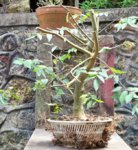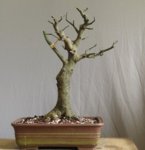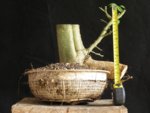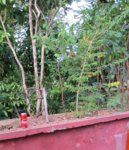Anthony
Imperial Masterpiece
Clicio,
we use a colander in the ground [ growing trough ] because it allows the
roots to escape and create trunks of 8 to 10 cm, in as little as 6 months [ see Chlorophora t.]
and can add in 6 branches.
When you remove the colander from the the ground growing. The colander allows the
tree to regenerate fine feeder roots in a month or two.
Then you can cut off the thick roots safely.
Next stage is branch refinement in [ in our case we use over size plastic bonsai pot from Dallas Bonsai ]
There is no use for a colander in the --- Refinement Stage.
Images will follow.
@MrFancyPlants ,
the explanation is in Bonsai Today - the double colander encourages the J.B.pine to grow coarse
surface roots, as does the triple.
The idea is to have a pine with surface roots.
Will not work on a hard wood pine [ eg. Caribbean/Honduran lumber pine ] but will
work on a softwood - J.B.pine.
Good Day
Anthony
Colander dug up and tree left to recover fine feeder roots [ Celtis l - Hackberry ]

Same tree in a bonsai pot for refinement of branches may take 5 years.
[ Celtis l. - Hackberry - we use a fridge to simulate winter ]

Chlorophora t. [ Clicio grows in your country, try it ]
This was grown as a supply for cuttings in another part of Trinidad [ another Bonsai Group ]
Took around 6 months of ground growing, and then after being dug up, left to regenerate
the fine feeder roots.

we use a colander in the ground [ growing trough ] because it allows the
roots to escape and create trunks of 8 to 10 cm, in as little as 6 months [ see Chlorophora t.]
and can add in 6 branches.
When you remove the colander from the the ground growing. The colander allows the
tree to regenerate fine feeder roots in a month or two.
Then you can cut off the thick roots safely.
Next stage is branch refinement in [ in our case we use over size plastic bonsai pot from Dallas Bonsai ]
There is no use for a colander in the --- Refinement Stage.
Images will follow.
@MrFancyPlants ,
the explanation is in Bonsai Today - the double colander encourages the J.B.pine to grow coarse
surface roots, as does the triple.
The idea is to have a pine with surface roots.
Will not work on a hard wood pine [ eg. Caribbean/Honduran lumber pine ] but will
work on a softwood - J.B.pine.
Good Day
Anthony
Colander dug up and tree left to recover fine feeder roots [ Celtis l - Hackberry ]

Same tree in a bonsai pot for refinement of branches may take 5 years.
[ Celtis l. - Hackberry - we use a fridge to simulate winter ]

Chlorophora t. [ Clicio grows in your country, try it ]
This was grown as a supply for cuttings in another part of Trinidad [ another Bonsai Group ]
Took around 6 months of ground growing, and then after being dug up, left to regenerate
the fine feeder roots.


